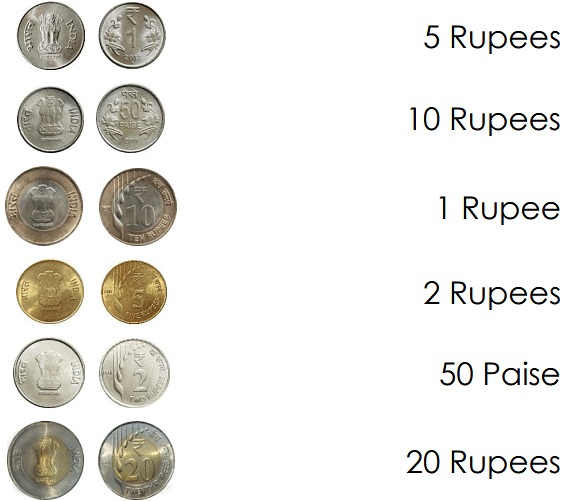Class 1 Exam > Class 1 Notes > Mathematics for Class 1 > Worksheet Solutions: Money - 2
Money - 2 Class 1 Worksheet Maths Chapter 12
Q1: Draw a line to match each coin with its name.

Ans:

Q2: Draw and label the 6 coins.
 Ans:
Ans:
Q3: Draw a line to match each coin with its value.

Ans:

Q4: Draw the 6 coins in order from least valuable to most valuable.
Ans:
Q5: Which of the following you can buy from  note?
note?
(a) 
(b) 
(c) 
(d) 
Ans: (a)
Pencil which is of Rs. 5 can be bought from Rs. 10 note.
Q6: Which set of coins shows Rs. 5?
(a) 
(b) 
(c) 
(d) 
Ans: (d)
50p + 50p= Rs.1.
Rs.1 + Rs.1 + Rs.2 + Rs.1
= Rs.5
Q7: Mohan has four Rs. 5 coins, out of which he gave 3 Rs. 5 coins to buy a toy. How much money, he is left with?
(a) Rs.2
(b) Rs.5
(c) Rs.10
(d) Rs.1
Ans: (b)
4 Rs. 5 coins, =? 20. 3 coins of Rs. 5
= Rs. 15. 3 coins
= 
He is left with 
The document Money - 2 Class 1 Worksheet Maths Chapter 12 is a part of the Class 1 Course Mathematics for Class 1.
All you need of Class 1 at this link: Class 1
|
15 videos|135 docs|23 tests
|
FAQs on Money - 2 Class 1 Worksheet Maths Chapter 12
| 1. What are the different types of money mentioned in the article? |  |
Ans. The article mentions three types of money: commodity money, representative money, and fiat money. Commodity money is any physical object that has value in itself, such as gold or silver. Representative money is backed by a physical commodity, like a certificate that can be exchanged for gold. Fiat money is money that is not backed by a physical commodity but is declared by the government to be legal tender.
| 2. How does money serve as a medium of exchange? |  |
Ans. Money serves as a medium of exchange by providing a common unit of value that can be used to trade goods and services. Instead of directly bartering one good for another, people can use money as an intermediary, making transactions more efficient. Money eliminates the need for a double coincidence of wants, where both parties in a trade must want what the other has.
| 3. Is money a store of value? |  |
Ans. Yes, money is considered a store of value. It allows individuals to save their wealth for future use. However, the value of money can be affected by inflation, which erodes its purchasing power over time. To preserve the value of money, individuals may choose to invest in assets like stocks, bonds, or real estate.
| 4. How does the article explain the concept of "legal tender"? |  |
Ans. The article explains that legal tender refers to the currency that a government has declared as acceptable for payment of debts within its jurisdiction. This means that creditors are legally obligated to accept the designated currency as a form of payment. However, legal tender laws do not necessarily mean that other forms of payment, such as credit cards or checks, cannot be used.
| 5. What are some advantages and disadvantages of using fiat money? |  |
Ans. Some advantages of using fiat money include its convenience, as it is widely accepted and easy to carry, and its flexibility, as the government can adjust the money supply to stabilize the economy. However, fiat money is susceptible to inflation, as the government can print more money, leading to a decrease in its value. Additionally, fiat money relies on the trust and confidence of the public in the government's ability to maintain its value.
Related Searches
















